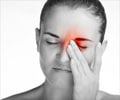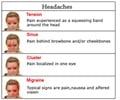
"We developed this technology and methodology in order to get the currents deep into the brain," said Dr. Marom Bikson, associate professor of biomedical engineering in CCNY's Grove School of Engineering,
The researchers aimed to tap into the so-called pain network, among other areas, a collection of interconnected brain regions involved in perceiving and regulating pain.
Professor Bikson and his colleagues, including Dr. Alexandre DaSilva at the University of Michigan School of Dentistry and Dr. Felipe Fregni at Harvard Medical School, found that the technology seems to reverse ingrained changes in the brain caused by chronic migraine, such as greater sensitivity to headache triggers.
Repeated sessions reduced the duration of attacks and decreased the pain intensity of migraines that did occur on average about 37 percent. The improvements accumulated over four weeks of treatment and they persisted.
Advertisement
Professor Bikson expects that a patient could use the system every day to ward off attacks, or periodically, like a booster.
Advertisement
"The fact that people still suffer from migraines means that the existing treatments using electrical technology or chemistry are not working," said Professor Bikson.
Existing brain stimulation technologies can help relieve a migraine already underway. But those afflicted with chronic migraine pain may suffer 15 or more attacks a month, making treatment a constant battle.
The other techniques also have drawbacks - from heavy, unwieldy equipment to serious side effects, such as seizures. Some only stimulate the upper layers of the brain. Others reach deep brain regions, but require brain surgery to implant the electrodes.
The tDCS technology is safe, easy to use, and portable, claimed Professor Bikson.
"You can walk around with it and keep it in your desk drawer or purse. This is definitely the first technology that operates on just a 9-volt battery and can be applied at home," he said.
He envisions future units as small as an iPod.
The next step will be to scale up clinical trials to a larger study population. A market-ready version of the tDCS is still years away.
They will publish their results, which is currently available online, in the journal "Headache."
Source-ANI














